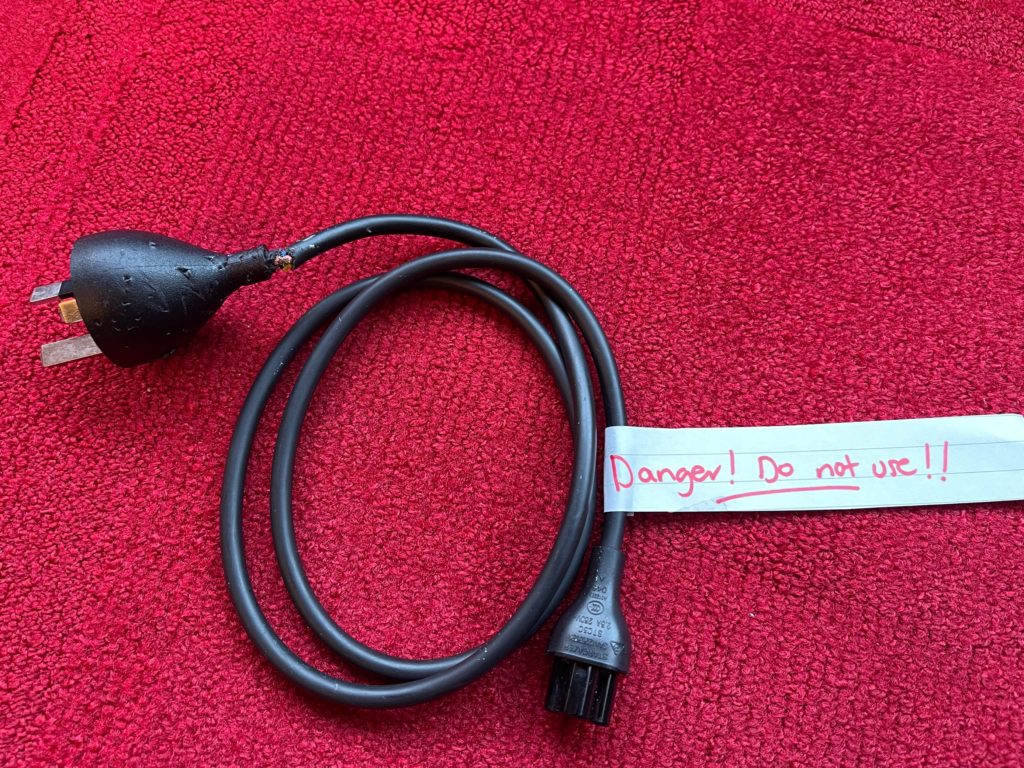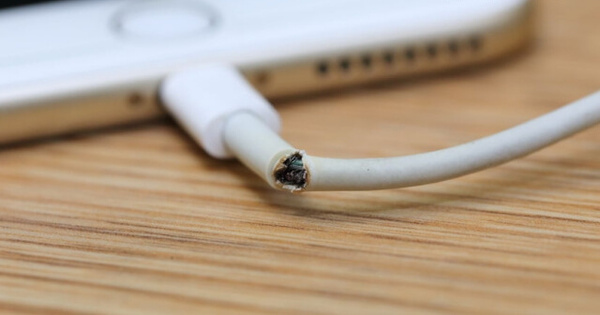A Nasty Electrical Shock – 5 Tips to Avoid them ⚡☠️

This is Simba, my daughter Ruby’s reward for smashing her HSC results – over 95%, and that was during lockdown with no teachers and plenty of isolation. I’ve instructed my wife to stop making bets with Ruby. It’s awesome seeing her so happy, they are best buddies. 💓

You may recognize his name from the Lion King. A Disney film in which Simba inadvertently lures his father to his death, by blindly blundering into his Uncle Scars’ evil plan… while our Simba wasn’t following a diabolical plan, he did almost get me killed.
Let me tell you what led to this shocking experience, and how to avoid it.
A Big Shock
Simba being a puppy, likes to chew things (everything!). Unfortunately, he thought my laptop cable would be an awesome chew-toy.
I think you can see where this is heading… Yes, I was shocked. Fortunately (unlike Mufasa), I survived to tell the tale.
I was in SSW Brisbane and realized I needed to quickly pack up to make my flight. Not realizing the cable on my laptop had been damaged by puppy teeth, I reached over the table to pull out my laptop plug, and I was shocked with about 230 volts (Australia previously had 240 volts). I clearly felt it go up my arm, and down the right side of my body. Fortunately, I was standing on 1 leg to reach to across the desk, which I think stopped it reaching my heart. If it had, it could have been fatal. I think I was only attached for about half a second, and I was also able to remove my hand… thankfully I didn’t get stuck to the plug.
It was horrible… My whole body went into shock, and I felt unwell for days. I’ve since found out that the reason I felt so ill, is because your blood pressure drops. Your body responds by going into protection mode and constricting (narrowing) your blood vessels in your hands and feet, and you get an intense sense of foreboding.
It’s painful, it makes you feel anxious, and the after-effects can last for days. In some cases, you can receive burns, damage tendons, muscles and/or ligaments, really scary stuff. Luckily, I was relatively unharmed.

Can your watch save your life?
I was lucky that a close friend Bridget Walker, a cardiothoracic nurse, jumped on the phone with me and talked me through doing an ECG on my Apple watch. I needed help quickly because I didn’t want to miss my flight.
Did you know that you can do electrocardiogram (ECG) on an Apple Watch? A bloke from the UK called Ed Dente, downloaded the new app to play around with it. Long story short, the watch said that he had an irregular heartbeat. He didn’t believe it at first and assumed it was a glitch, so he tested it on his wife and child, who both came back normal. Every time he re-tested himself he got the same irregular result. Concerned he then went to see a doctor who confirmed his condition. Left untreated it could have killed him. 🤯

It’s pretty incredible tech, but honestly, it wasn’t that easy to use when you’re feeling a bit panicked. You find the app on your watch, which isn’t easy. The app isn’t very obvious on the home screen, and for future reference, when the app asks you to hold you finger on the ‘crown’, it means the button on the side of the watch…

Credit: https://abcnews.go.com/Health/apple-watch-told-46-year-man-irregular-heartbeat/story?id=59726093
You can lose your life
I was a bit ambivalent when I saw dodgy cables, I’ve had iPhone from the beginning, and most of my cables aren’t in great shape. So learn from me:
#1. ⚠️ Don’t use damaged cables! I’d love to know if you were like me, and kept using damaged cables while they worked. This is a no brainer, chuck them.
At work – they should also be tested and tagged every 6 months by a qualified electrician to make sure they’re safe, even if they look ok.
There are a few other reasons you shouldn’t still use them:
- You’re damaging your devices! Even a frayed cable stops the electricity flowing properly, which can cause power surges that damage your phone
- It can cause a fire – frayed cables can lead to overheating and this can be a huge fire risk when left unattended or while you’re asleep
- You’re still at risk of shock – even though it looks safe, the protective layer is broken. There is nothing to stop the electrical current flowing through these wires and you can get a nasty burn or shock
- You could harm someone else – if you’re not the only one home, someone you love might touch it and be zapped
- You could lose your life.

#2. ⚠️ Always use a qualified electrician – they can check things like your Residual current device (RCD) is working properly, which is something installed in your main switch board that should trip out when a current of 30 milliamps is detected. It cuts the power off really quickly, which will save your life! Also, they can check your main earth to make sure that it can carry the current properly to earth.
#3. ⚠️ Keep electrical appliances away from water, including your bathroom
#4. ⚠️ Don’t tightly coil your cables when storing, and make sure they are totally uncoiled when in use. This will help prevent breaks, or stretching the cord as well as overheating
#5. ⚠️ Unplug appliances when not in use – it saves electricity but also reduces the risk of fire
⚠️ Bonus Tip: Always try to use genuine cables. There are a few counterfeit cables floating around, and they are not made for purpose (or to Australian standards) – they have lead to a number of shocks, fires and tech failures!
I hope these 5 tips help you and your loved ones. Cable safety is no joke.
Been zapped? I’d love to hear your experience.

August 19, 2022 @ 2:21 AM
I know how you felt.
Many years ago (Shhhh!) I sent -385V up my right arm. (DC is the stuff that makes your muscles lock.) Alone, I was sitting cross-legged on the floor testing a faulty Short Wave Radio receiver I had built. My finger was touching the metal part of the test probe when I touched the grid of a pentode valve. Zap! My fingers locked on. Fortunately I had the presence of mind to rock myself back and forth until I broke contact.
I should have known better (been more careful) but I survived; a wiser man.
August 19, 2022 @ 9:41 PM
That’s a scary and nasty thing to happen and very glad you are recovering. Do please follow up with the office. You said it was SSW Brisbane so that’s a commerical workplace. Here, quote: “the Queensland Electrical Safety Regulation requires workplaces to have RCDs (safety switch) protection and regular trip time testing to ensure these devices provide adequate protection in the event of electric fault. In most cases, RCDs must be tested every six (6) months. ”
If the RCD was working you wouldn’t have experienced what you did.
October 28, 2022 @ 11:27 PM
I knocked myself off a ladder once because I thought the power was off trying to replace a light and I didn’t test it… and got super lucky. Always make sure you turn the breaker off and don’t be like me… spend the money on a voltage tester to make sure it isn’t live (even after you flip the switch on the electrical panel).
April 17, 2023 @ 2:26 AM
Great article! Electrocution is a serious and potentially life-threatening hazard that can occur in a variety of settings, from the workplace to the home. To avoid electrocution, it is important to follow proper electrical safety practices such as turning off the power before performing electrical work, using insulated tools and gloves, and keeping electrical equipment dry and away from water sources. It is also important to avoid touching electrical equipment with wet hands or when standing on wet surfaces. Regular maintenance, inspection, and repair of electrical systems can help prevent accidents caused by faulty wiring or damaged equipment. Lastly, being aware of the potential hazards and following safe electrical practices can help protect yourself and others from the risks of electrocution.
September 27, 2023 @ 8:35 PM
Your detailed explanations and practical tips for electrical safety are not only informative but also crucial for everyone to understand. Electricity can be both a powerful resource and a potential hazard, and your post provides valuable insights into how to navigate it safely.